#archaeologist habits
Explore tagged Tumblr posts
Text
that tag re: last post is essentially what almost every paper my professors recommended was like dfhf
#archaeologists love to say things like well ok classicists maybe blorbo WASN'T THAT RELEVANT#as the burn layer shows continued habitation after-
3 notes
·
View notes
Text

**still trying to find a way to do clean inks that I don’t hate but the fact that they’ll make the same gestures/expressions at the same time without meaning to is so cute I had to memorialize it.
**post divorce Bobby reverting to mamas boy is so personal to me
#**to be clear Aggie isn’t a ~boy mom~ and Bobby isn’t a codependent weenie#**they’re just v close and are buddies#**it was just the two of them for so long and now he’s back home and they just fall into old habits#**mun art#**the witch#**the archaeologist
1 note
·
View note
Note
Hi there!
I'd like to request something for the Laios party x reader where reader licks rocks like how archaeologists sometimes do to determine if it's a rock or a fossil. They just won't stop licking stuff. One moment you are just having a chat and walking side by side and the next reader grabs a rock and licks it. How would they react to their crush licking things that are certainly not food?

“stop licking the damn thing!”
…ft! touden party x gn! reader, platonic izutsumi & reader
…tags! fluff, some crack, headcanon format, grimm doesn't know shit about rocks
…wc! 342 ; 400 ; 405 ; 344 ; 303 = 1794
…notes! this ask enraptured me i had to complete it posthaste. i’m not an expert in archeology or geology, but i hope you enjoy!

Laios
“Ooh, can I have a lick?”
His ass does NOT give a fuck.
You could do anything and he wouldn’t be fazed I’m dead serious.
Honestly, once you do it in front of him he’d steer the conversation towards your study and how you figure out each time what is a rock and what is a fossil.
He may not fully take in all the information you give him. This isn’t a topic he’s admittedly too interested in.
Honestly he’d probably take up some of your advice and see if he tastes monster he can figure out certain things about it. Considering most monsters are made of raw meat, he has to be held back by your fellow partymates.
Someone (Chilchuck) usually has to encourage you to not “enable his behaviours.”
Overall, Laios simply does not judge! He’s open and welcoming, and will even take part in your study with you!
(It’s an added bonus that he really likes how you explain things to him…)
Almost like an eager dog, Laios leans over your shoulder to look at the stone in your hand. Prepared to explain yourself, like usual, you take a breath. “May I?” he interrupts you. You still for a second. Does he mean…? You slowly lift the rock up to the taller man behind you. You don’t have any words as he leans down to give a small lick. You’re almost flattered from how open he is to it. At the taste, Laios’ eyebrows furrow, and he seems to seriously try to dissect the flavour. He hums and tilts his head to you. “Salty?” “Yeah,” you reply, slowly growing a bit more comfortable as you get an excuse to talk about your study, “so that means this rock might contain evaporite minerals.” Laios smiles slightly, leaning back to his full height to converse with you in a more casual position. “Which are?” Your conversation continues, with Laios taking mental notes that he’ll hopefully remember for later next time he comes across a monster. Maybe if you find a gargoyle…

Marcille
Sorry she is so judgemental.
You are so lucky she likes you or else she’ll loudly give her opinion on how gross it is.
Well, that is until she learns the context as to why.
She’ll still be a little bit unsure, wondering if it’s proper conduct at all.
Marcille is trying her best, she really is, but you can’t just end a conversation so suddenly because you saw a rock, licked it in front of her, and said “hm… sedimentary.”
She wonders every day what she did to deserve such an… interesting taste in crushes.
Though, like all things, give Marcille some time and she’ll warm up to your habits a bit more. It may even be that she’ll be wondering about her study of the dungeon, running her hand along the wall, and thinking that she could call out to you to taste the wall and tell her the material.
She may not try out the method herself, but she’ll at least tolerate how you do it. There’s a science behind it, after all…
Marcille stares as you lick your lips and hum to yourself. Her mouth is a thin line and she’s trying her best not to come out with a disapproving comment. “Any… interesting findings…?” She stiffly asks instead, gripping Ambrosia as if you’ll try licking her to figure out the levels of Mana too. You can never be too cautious, even if she is only made out of wood. You smile at Marcille, either blissfully unaware of her austerity or pretending to be. You hold up the stone in your hand and outline something with your finger. “I think if we break this, we might find some fossils inside it. You can keep it for your research if you want.” Marcille’s ears perk up slightly at that. “For… me?” She asks aloud, as if there’s anyone else who’d be interested in dungeon rocks. As soon as she processes it she’s flushed and avoiding eye contact. “I mean, this is your field of study, not mine! I couldn’t possibly…” But you take her hands in your own, and place the fossil in her palm. Marcille’s breath hitches when you take her fingers and fold them over the stone. “I trust you to come up with something.” You beam at the elf, and she thinks that she might just have to take a chance in your skills.

Chilchuck
Not exactly open to it, not entirely critical about it either…
…But you will get a bit of a look whenever you do it.
He might be more the kind to make sure you aren’t outright doing it at stupid moments. You better not get any ideas looking at those statues!
Sometimes you’ll be about to hold the stone up to your mouth, and right when your tongue is about to touch it, you’ll hear Chilchuck sigh a “don’t.”
Honestly this guy is treating you like a dog with something it shouldn’t have in its mouth. Don’t worry, worrying and fretting is how he shows his love.
Even if he doesn’t like admitting to it…
If you try to explain how licking things helps in your study, Chil is inclined to raise his eyebrow and say that your field must be full of weirdos.
Then again, he’s the one who likes you so maybe he shouldn’t be too harsh…
He’s willing to let you do what you need to do but that doesn’t mean you’re free from his scathing commentary.
Crouched down, you analyse some rock in front of you. It stands out a fair bit from most of the other geodes down here. What could it be…? You lean in, your tongue grazing the stone slightly, and you lick. The tip of your tongue familiarises itself with the taste. Maybe metamorphic…? “Are you serious?” You freeze at the sound of Chilchuck’s boyish voice. On your hands and knees licking rocks isn’t exactly the ideal position to be judged in, even as you turn to look at the half-foot, arms crossed. “Senshi is in the middle of cooking, no need to resort to eating rocks.” You roll your eyes. You’re used to how Chilchuck treats your study at this point. “I was just curious.” Chilchuck scoffs, walking up to pull you by the back of your collar up onto your feet again, which you do with some coercion. “Yeah sure,” he says, “just wanna confirm you haven’t completely lost your marbles yet.” You look up at him, and squint. Holding back a laugh, you mutter, “was that…?” “No, it wasn’t a dad joke,” Chilchuck sighs, leaving you to your devices again. “Just don’t do anything stupid when no one’s watching.” He hopes even as you giggle and confirm, you won’t notice the bright blush blooming on Chilchuck’s cheeks and tips of his ears. How embarrassing…

Senshi
Also winning the dgaf war I fear.
He’d watch you lick some of the rocks you had picked out from your travels while resting.
It comes as no surprise that it then crosses his mind if the flavour changes when cooked, which he asks if he can do with some of your selection.
You can use your imagination on how Marcille and Chilchuck reacted when told that today’s dinner is … just rocks.
(Laios is disappointed that it isn’t any cool monster rocks.)
One delightful montage later, and ‘tis finished! Since they are for your research, Senshi insists you have the first bite.
Crunch… and oh, such unique flavours!
You gush to Senshi about how this is a major breakthrough in how different minerals react to cooking conditions, and he gives you his observations too.
Honestly, just sort of wholesome bonding!
“Aye, this one cooked easily, while this one took plenty more time.” You nod eagerly as you watch Senshi point to two different stones. “That’s because one is an igneous rock, which is magmatic. The other is a sedimentary rock, which carries different minerals from lakes and oceans. Separation in cooking must have resulted in different reactions! I wonder how different metamorphic rocks would react…” As you mumble to yourself, Senshi happily continues his meal-making, occasionally responding back to you with hums and comments about what else each observed in his experimentation. Even when you had finished up your meal entirely, you thanked Senshi with the widest grin on your face. He couldn’t help but be just a little flattered when you go on to joke that you should bring him home with you so he can help with your research. In return, Senshi listens to you, and hangs on your every word as you explain your findings to him. Even if not too nutritious of a meal, the minerals from the rocks provide some calcium and other such buffs! And well… If he can keep that happiness prolonged with his cooking, then he’s doing a very good job providing for you indeed!

Izutsumi
“Why are you eating rocks? Looks gross.”
Make way for the #1 hater…
Izutsumi refuses to listen to any such rationalities you make about your study or why you lick rocks (even though she’s the one who asked), she’s still finding it icky and weird.
You’d have to fight fire with fire when it comes to her, you’ll question why she does some habits she does in return – such as licking her hand.
She’ll look at you like you’re stupid, before telling you that it’s a way for her to clean herself and notice if there’s anything caught in her fur.
“Ah, so like how I would lick rocks to identify anything embedded in them too!”
…How dare you try to rationalise yourself with her own logic, heathen.
Jail for reader. Jail for 1000 years.
She’s not one to so readily accept other people’s weird quirks, but eventually she has to find that she’ll look stupid if she doesn’t… It’s a bit of a dirty scheme, but it works.
“Come on, Izu, just give it a try! I promise it just tastes like water.” “What kinda water?!” She shoots back. You pause. “W…Water?” This is how the argument between whether or not water has a flavour comes to be. Izutsumi insists that some water tastes icky while others taste nice. You have to explain that this pure water simply doesn’t have a taste. She doesn’t believe you. In fact, Izutsumi makes you give the sedimentary stone another taste before affirming, it just tastes like water. She’s about to grab your shoulders and shake you. What kind of water?! It takes plenty of encouragement and an immediate failsafe orange juice Senshi squeezed out for her to ‘get rid of’ the taste when you get Izutsumi to taste the stone. She still hasn’t forgiven you…

#✮ grimm's fics!#delicious in dungeon#dungeon meshi#laios touden#laios touden x reader#laios#laios x reader#laios touden imagines#laios imagines#dungeon meshi x reader#dungeon meshi imagines#delicious in dungeon imagines#delicious in dungeon x reader#marcille donato x reader#marcille donato#marcille x reader#marcille delicious in dungeon#marcille dungeon meshi#marcille donato imagines#chilchuck imagines#chilchuck#chilchuck tims#chilchuck tims x reader#chilchuck x reader#chilchuck tims imagines#senshi#senshi of izganda#senshi x reader#senshi imagines#izutsumi
2K notes
·
View notes
Text
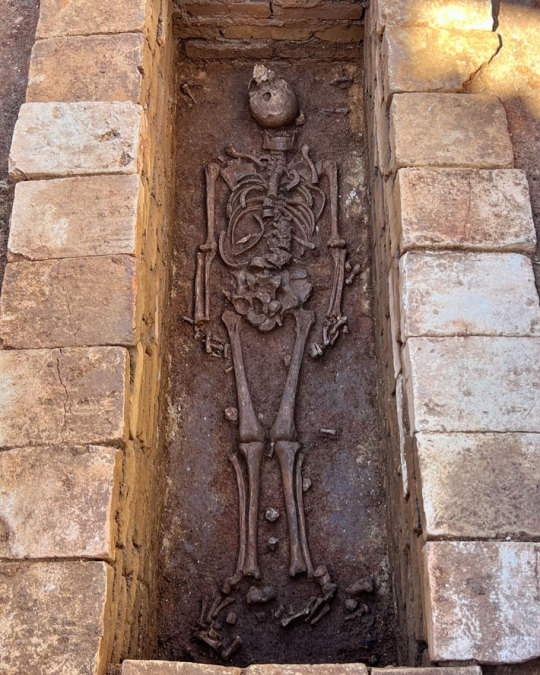
Three Roman Graves Uncovered in Portugal
Three burials dating to the 5th or 6th century AD have been unearthed in the ancient Roman city of Ossónoba in Faro, southern Portugal.
The Ossónoba’s first archaeological evidence dates back to the 4th century B.C., when the Phoenicians settled in the Western Mediterranean. The city was then called Ossónoba From the 2nd century B.C. until the 8th A.D. the city was under Roman and Visigoth dominance being afterwards conquered by the Muslims in 713.
A team of archaeologists from ERA Arqueologia discovered ancient Roman structures and the remains of a man, woman, and child while conducting excavations over a 5,000 square meter area that will eventually house a real estate development.
The excavations, which took place before a construction project, revealed the grave of a man whose skeleton was complete and who would have been between 39 and 45 years old, as well as a young woman under the age of 25, and a baby who would have been no more than six months old, according to archaeologist Francisco Correa.
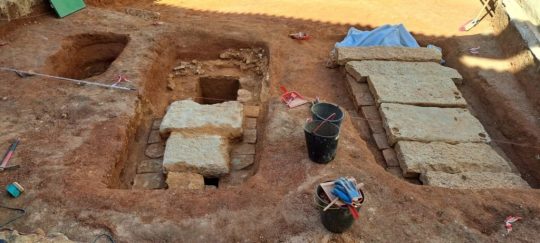


Francisco Correia, the project’s head archaeologist, said in a statement that the discoveries were made in an old truck repair workshop and are believed to date from the 5th or 6th century.
The tombs appear to have been looted in the past to steal “small bracelets, necklaces, and rings,” according to anthropologist Cláudia Maio. The tombs indicate that the people may have had “some economic status” as they were not simply placed in open graves but instead buried in carefully built graves.
The proximity of the three people’s graves seems to indicate that they were family members, though the team cannot be certain of that. “But we cannot say anything for sure,” the anthropologist said.
To learn more, the researchers hope to be able to provide more precise answers through DNA tests and isotopic analysis techniques used to determine population movements and dietary habits from chemical traces in ancient human remains.
This latest archaeological discovery did not come as a surprise to archaeologists, who had already led similar works which resulted in the discovery of a Roman game artifact believed to date back to the first century AD in 2020.
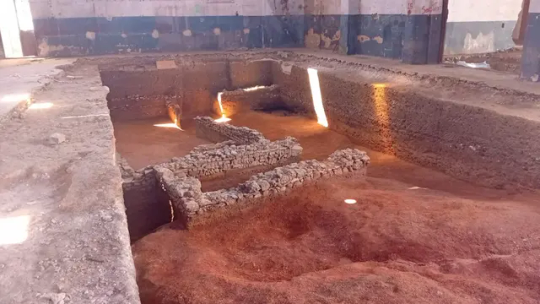
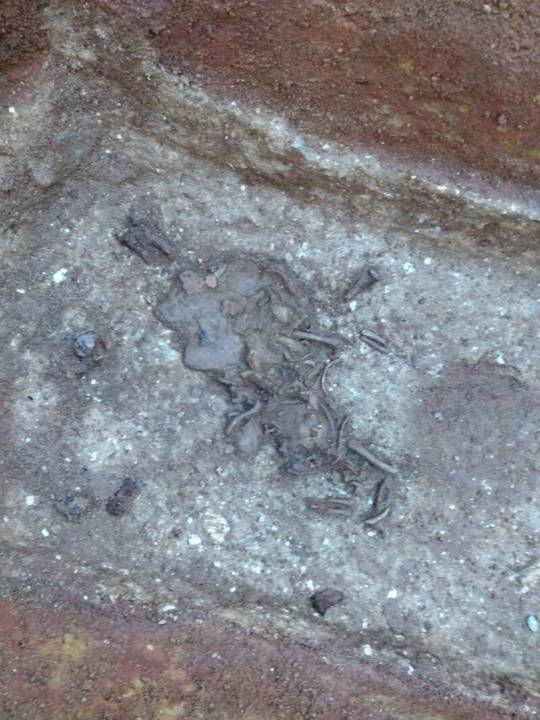

“We know that we are in an area with archaeological potential where there is a 17th-century convent (of Santo António dos Capuchos) to the west, and to the east lies the area where the mosaic of the Ocean God (Deus Oceano), now a national treasure, was found,” he said.
What did come as a surprise to archaeologists was the location of the tombs.
“Based on previous studies, this would have been an area that was possibly residential or more linked to industrial activities. There are many traces of salterns. Largo da Madalena would have been the entrance to the urban area of the city of Ossónoba. The identified graves are in the Figuras area, near Teatro Lethes, close to the Ermida de São Sebastião and the Pavilion of Escola D. Afonso III. This area is almost within the urban fabric,” the archaeologist explained, adding that this illustrates both the “growth and decline of Ossónoba.”
The graves of the man and the woman “were sealed with limestone slabs,” believed to be reused parts from “some of the most emblematic buildings that would have been here in the area,” he believes.
According to the project manager of ERA Arqueologia, who was co-responsible for the work, in addition to the graves, hundreds of small pieces were also discovered which suggest that there may also have been a mosaic there.
The researchers also recovered Roman artifacts in the area, including ceramics, bone dice, nails, pins, a spoon, possible evidence of a dye factory, and coins minted during the reign of Constantine the Great, between A.D. 306 and 337.
Cover Photo: Roman mosaic of the god Oceanus, part of the ancient city of Ossónoba, the modern town of Faro, in Portugal.
By Leman Altuntaş.
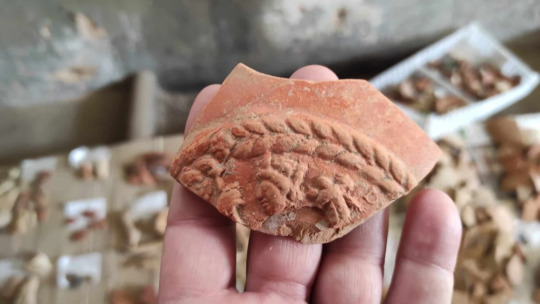
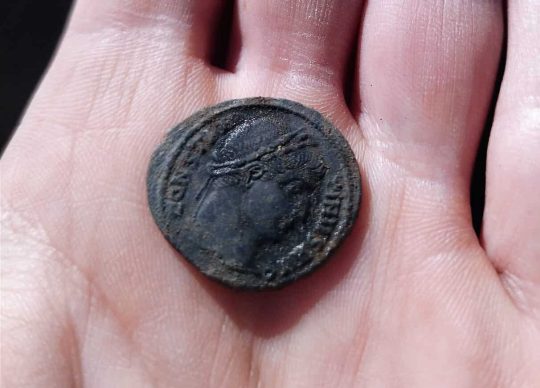
#Three Roman Graves Uncovered in Portugal#Roman city of Ossónoba in Faro#ancient grave#ancient tomb#ancient artifacts#archeology#archeolgst#history#history news#ancient history#ancient culture#ancient civilizations#roman history#roman empire#roman art
257 notes
·
View notes
Photo
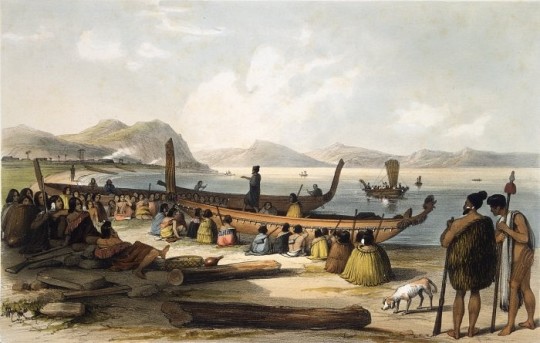
Polynesian Navigation & Settlement of the Pacific
Polynesian navigation of the Pacific Ocean and its settlement began thousands of years ago. The inhabitants of the Pacific islands had been voyaging across vast expanses of ocean water sailing in double canoes or outriggers using nothing more than their knowledge of the stars and observations of sea and wind patterns to guide them.
The Pacific Ocean is one-third of the earth's surface and its remote islands were the last to be reached by humans. These islands are scattered across an ocean that covers 165.25 million square kilometres (63.8 million square miles). The ancestors of the Polynesians, the Lapita people, set out from Taiwan and settled Remote Oceania between 1100-900 BCE, although there is evidence of Lapita settlements in the Bismarck Archipelago as early as 2000 BCE. The Lapita and their ancestors were skilled seafarers who memorised navigational instructions and passed their knowledge down through folklore, cultural heroes, and simple oral stories.
The Polynesian's highly developed navigation system impressed the first European explorers of the Pacific and since then scholars have been debating several questions:
was the migration and settlement of the Pacific islands and into Remote Oceania accidental or intentional?
what were the specific maritime and navigational skills of these ancient seafarers?
why has a large body of indigenous navigational knowledge been lost and what can be done to preserve what remains?
what type of sailing vessels and sails were used to cross an open ocean?
Ancient Voyaging & Settlement of the Pacific
By at least 10,000 years ago, humans had migrated to most of the habitable lands that could be reached on foot. What remained was the last frontier – the myriad islands of the Pacific Ocean that required boat technology and navigational methods be developed that were capable of long-range ocean voyaging. Near Oceania, which consists of mainland New Guinea and its surrounding islands, the Bismarck Archipelago, the Admiralty Islands, and the Solomon Islands was settled in an out-of-Africa migration c. 50,000 years ago during the Pleistocene period. These first settlers of the Pacific are the ancestors of Melanesians and Australian Aboriginals. The small distances between the islands in Near Oceania meant that people could island-hop using rudimentary ocean-going craft.
The so-called second wave of migration into Remote Oceania has been an intensely debated scholarly topic. Remote Oceania is the islands to the east of the Solomon Islands group such as Vanuatu, Fiji, Tonga, Aotearoa (New Zealand), Society Islands, Easter Island, and the Marquesas. What is debated is the origins of the first people who settled in this region between 1500-1300 BCE, although there is general agreement that the ancestral homeland was Taiwan. A dissenting view has been that of Norwegian adventurer Thor Heyerdahl (1914-2002 CE) who set out in 1947 CE on a balsa raft called Kon-Tiki that he hoped would prove a South American origin for Pacific islanders. Archaeological and DNA evidence, however, points strongly to a southeast Asian origin and seafarers who spoke a related group of languages known as Austronesian who reached Fiji in 1300 BCE and Samoa c. 1100 BCE. All modern Polynesian languages belong to the Austronesian language family.
Collectively, these people are called the Lapita and were the ancestors of the Polynesians, including Maori, although archaeologists use the term Lapita Cultural Complex because the Lapita were not a homogenous group. They were, however, skilled seafarers who introduced outriggers and double canoes, which made longer voyages across the Pacific possible, and their distinctive pottery – Lapita ware – appeared in the Bismarck Archipelago as early as 2000 BCE. Lapita pottery included bowls and dishes with complex geometric patterns impressed into clay by small toothed stamps.
Between c. 1100-900 BCE, there was a rapid expansion of Lapita culture in a south-east direction across the Pacific, and this raises the question of intentional migration.
Continue reading...
52 notes
·
View notes
Text
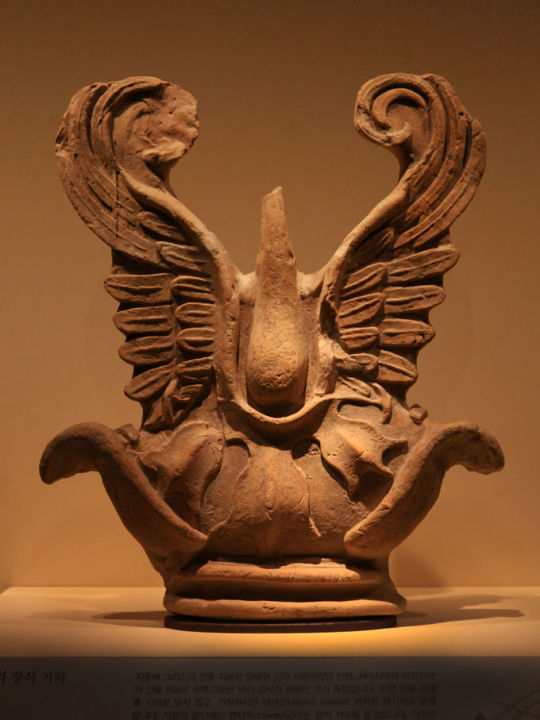


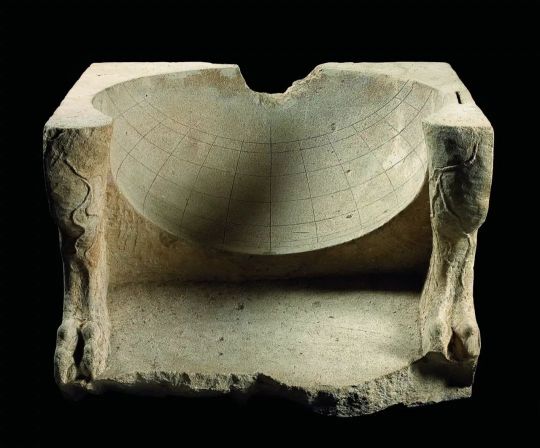
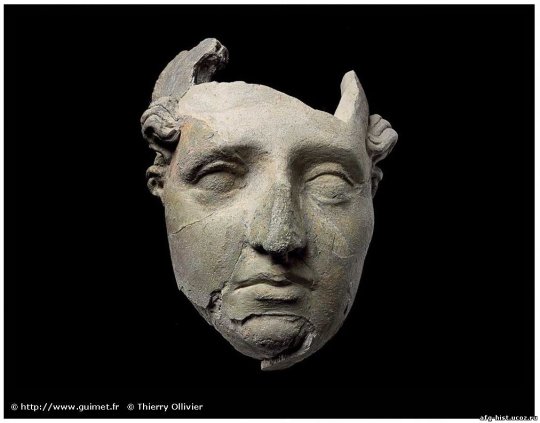

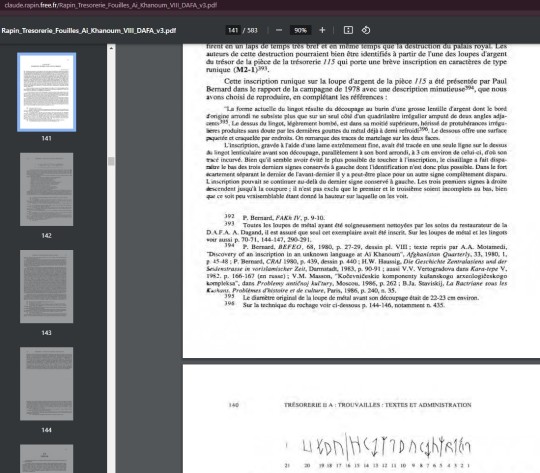
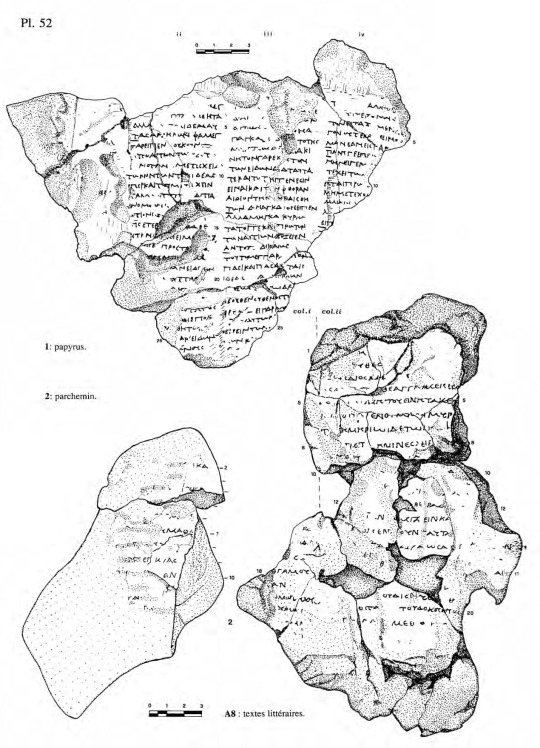
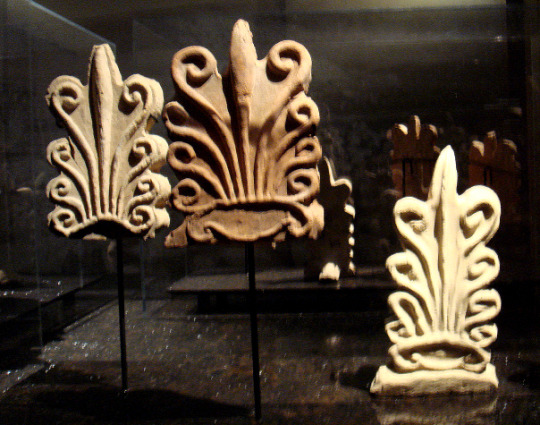





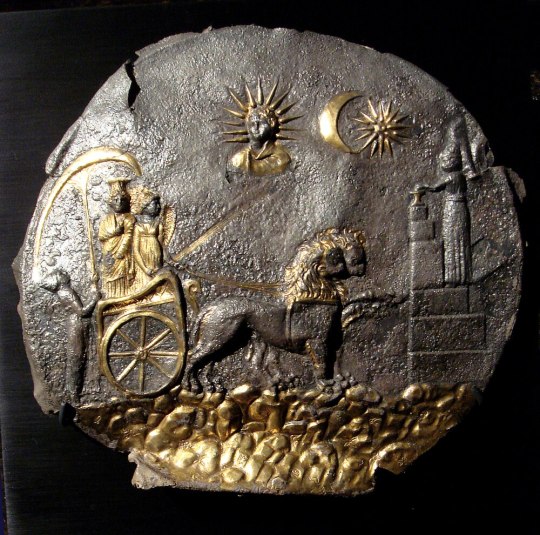

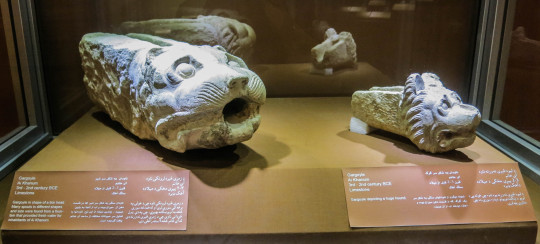

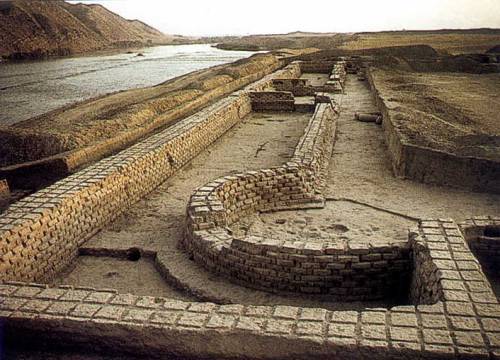



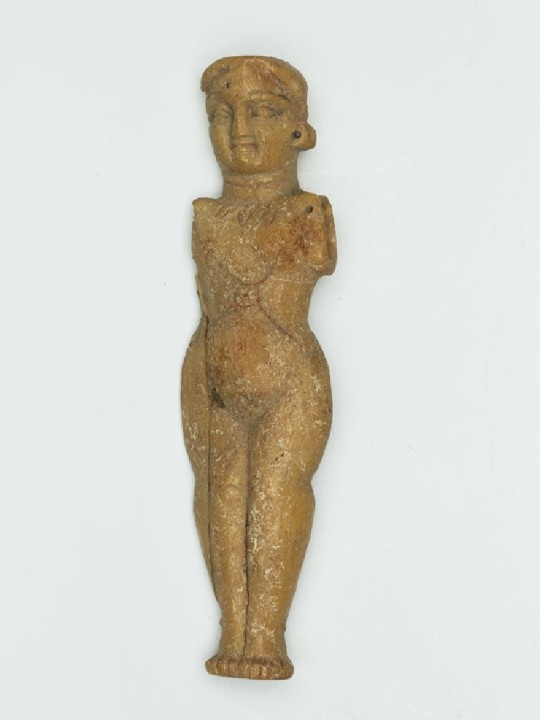





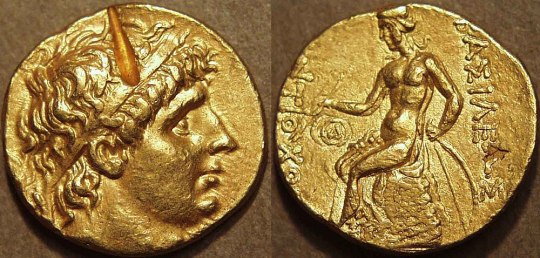

Ai Khanoum 3rd C. BCE - 2nd C. CE. More images on my blog, link at bottom.
"These wise sayings of men of old, The words of famous men, are consecrated At holy Delphi, where Klearchos copied them from carefully To set them up, shining from afar, in the sanctuary of Kineas.
As a child, be well behaved; As a young man, self-controlled; In middle age, be just; As an elder, be of good counsel; And when you come to the end, be without grief.
—trans. of Ai Khanoum stele by Shane Wallace and Rachel Mairs.
Ai-Khanoum (/aɪ ˈhɑːnjuːm/, meaning Lady Moon; Uzbek Latin: Oyxonim) is the archaeological site of a Hellenistic city in Takhar Province, Afghanistan. The city, whose original name is unknown, was likely founded by an early ruler of the Seleucid Empire and served as a military and economic centre for the rulers of the Greco-Bactrian Kingdom until its destruction c. 145 BC. Rediscovered in 1961, the ruins of the city were excavated by a French team of archaeologists until the outbreak of conflict in Afghanistan in the late 1970s.
The city was probably founded between 300 and 285 BC by an official acting on the orders of Seleucus I Nicator or his son Antiochus I Soter, the first two rulers of the Seleucid dynasty. There is a possibility that the site was known to the earlier Achaemenid Empire, who established a small fort nearby. Ai-Khanoum was originally thought to have been a foundation of Alexander the Great, perhaps as Alexandria Oxiana, but this theory is now considered unlikely. Located at the confluence of the Amu Darya (a.k.a. Oxus) and Kokcha rivers, surrounded by well-irrigated farmland, the city itself was divided between a lower town and a 60-metre-high (200 ft) acropolis. Although not situated on a major trade route, Ai-Khanoum controlled access to both mining in the Hindu Kush and strategically important choke points. Extensive fortifications, which were continually maintained and improved, surrounded the city.
Many of the present ruins date from the time of Eucratides I, who substantially redeveloped the city and who may have renamed it Eucratideia, after himself. Soon after his death c. 145 BC, the Greco-Bactrian kingdom collapsed—Ai-Khanoum was captured by Saka invaders and was generally abandoned, although parts of the city were sporadically occupied until the 2nd century AD. Hellenistic culture in the region would persist longer only in the Indo-Greek kingdoms.
It is likely that Ai-Khanoum was already under attack by nomadic tribes when Eucratides was assassinated in around 144 BC. This invasion was probably carried out by Saka tribes driven south by the Yuezhi peoples, who in turn formed a second wave of invaders, in around 130 BC. The treasury complex shows signs of having been plundered in two assaults, fifteen years apart.
Although the first assault led to the end of Hellenistic rule in the city, Ai-Khanoum continued to be inhabited; it remains unknown whether this reoccupation was effected by Greco-Bactrian survivors or nomadic invaders. During this time, public buildings such as the palace and sanctuary were repurposed as residential dwellings and the city maintained some semblance of normality: some sort of authority, possibly cultish in origin, encouraged the inhabitants to reuse the raw building materials now freely available in the city for their own ends, whether for construction or trade. A silver ingot engraved with runic letters and buried in a treasury room provides support for the theory that the Saka occupied the city, with tombs containing typical nomadic grave goods also being dug into the acropolis and the gymnasium. The reoccupation of the city was soon terminated by a huge fire. It is unknown when the final occupants of Ai-Khanoum abandoned the city. The final signs of any habitation date from the 2nd century AD; by this time, more than 2.5 metres (8.2 ft) of earth had accumulated in the palace.
While on a hunting trip in 1961, the King of Afghanistan, Mohammed Zahir Shah, rediscovered the city. An archaeological delegation, led by Paul Bernard, unearthed the remains of a huge palace in the lower town, along with a large gymnasium, a theatre capable of holding 6,000 spectators, an arsenal, and two sanctuaries. Several inscriptions were found, along with coins, artefacts, and ceramics. The onset of the Soviet-Afghan War in the late 1970s halted scholarly progress and during the following conflicts in Afghanistan, the site was extensively looted."
-taken from Wikipedia
...
"The silver ingot engraved with runic characters found during the excavations of the Treasury could suggest they were Sakā/Sai. This inscription comprises 21 characters of a script and a language that are unknown and both attributed to nomadic people of Sakā origin, by comparison with a dozen similar inscriptions coming from an area extending from Ghazni in Afghanistan to Almaty in Kazakhstan, and dated between the 5th century BC and the 8th century AD."
-taken from Ai Khanoum after 145 BC: The Post-Palatial Occupation by Laurianne Martinez-Sève, University of Lille, 2018
#ancient history#antiquities#art#paganism#statue#museums#sculpture#history#greek art#greek gods#ancient greek#greek myth#scythian#pagan#ancient art#afghanistan
196 notes
·
View notes
Text
I got a load of those fact acts stewing in my inbox, so I thought I'd post a bunch about our fave lil lady.. 🤸♀️

Alex is 10!
Her birthday is July 18th! 🥳
She recently grew some new teef, but now she has to wear a stinky retainer at night.
Her & Brodie have been staying in Fabian's watchtower for a few months now, he said he'd be home sooner cos he thought he'd get yeeted home asap but alas.. 🤭
Alex's mom Nylah died when she was five.
Aside from the odd fall out, her and Brodie are pretty close though! They like to do puzzles together or go off exploring when they have time.
Alex was born in Sulani like her momma, Brodie's from Selvadorada though - they usually flit between those two places but their house is technically in Sulani.
Despite being from Sulani, Alex is a poor swimmer at best and doesn't usually entertain the idea of submerging herself in water.. unless it's a bath 🙈
Alex and Brodie stay with Brodie's uncle whenever they visit Selvadorada, it's usually cos Brodie has a lot of work there as an archaeologist.
They've been all over the place for Brodie's work, but her fave was probably Moonwood Mill.. it was fun to explore! (yes she got in trouble for wandering off there too)
Her favourite pastime is exploring when she's been told to stay put... 😅
She's been to a few schools in the past, but she's mostly home schooled via tutors.
Her favourite subjects are science and geography!
Her favourite colours are orange and purple-.. and green and maybe blue too, and yellow-.. she can't pick.
Her fave snacks are brookies 🤤
She has no idea what she wants to be when she grows up.. at one point she wanted to be an acrobat in a circus but she lost interest when she fell off a balance beam and broke her arm - Brodie said she should probably pick something that didn't require so much grace and balance lmaoo 😅
Alex has had a few pen-pals in the past but they've usually fizzled out, she has a bad habit of losing their addresses too - blame all the moving!!
She could spend hours painting her nails and drawing lil pictures on em and stuff 💅
Really REALLY wants a pet rat but Brodie thinks they're gross so no deal-.. they move around too much for pets anyway.
Alex can't put her finger on it either, but there's definitely something up with Robin 🤨
#ts4#sims 4#simblr#fib#fib extras#alex#sooooo many alex facts!#🤸♀️#feel free to ask abt anything i've missed tho#within reason!! gotta keep some intrigue too u kno#HUEEHU 🤭
83 notes
·
View notes
Text






Assistant Buck & Boss Eddie
Eddie, a dedicated boss, and Buck, his eager assistant, found themselves sharing a quiet dinner after a successful work trip. As they sipped their wine, Buck's nerves faded, and he began to excitedly blatter about his extensive Wikipedia knowledge on random topics, ranging from obscure historical events to the mating habits of rare birds.
"Did you know that honey never spoils? Archaeologists found pots of it in ancient Egyptian tombs that were over 3,000 years old and still edible!"
Eddie chuckled, a warm smile spreading across his face. “You’re adorable, you know that?”
Buck's cheeks flushed crimson, and he looked down, fidgeting with his napkin. The moment hung in the air, charged with unspoken tension. Eddie's heart raced as he watched Buck shy away, realizing that his feelings for him ran deeper than mere admiration.
As the night wore on, the conversation flowed seamlessly, and Eddie couldn't help but steal glances at Buck, imagining the man blushing for a different reason.
50 notes
·
View notes
Text
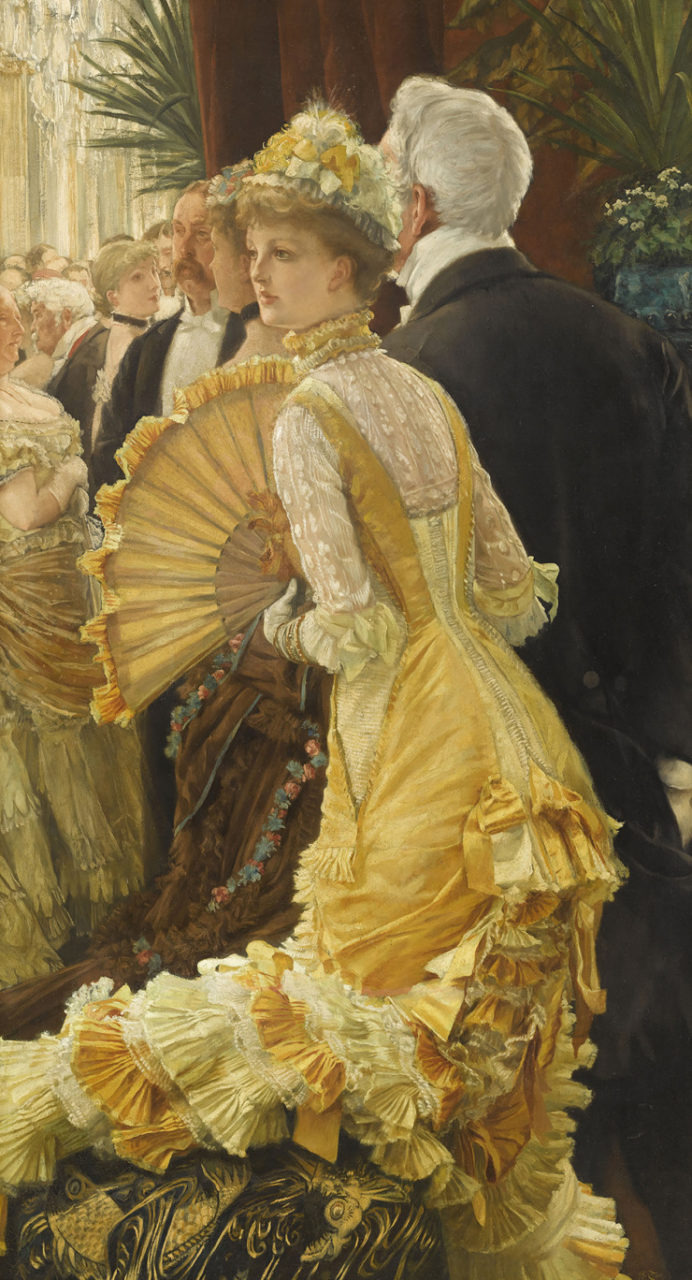
James Tissot (French) • The Ball, later renamed Evening • 1878 • Musée d'Orsay
James Tissot is known for painting elegant beautiful society women attired in the latest Paris fashions. He was also known to alter some details of a particular outfit by painting in his own flourishes to suit his taste and enhance the over-all portrait. He was criticized for this habit but it was undeniable that fashion designers of the time were paying attention. In this way, Tissot was a fashion influencer of high Victorian society.
It's only natural that Tissot was interested in the attire of his well-to-do patrons. His father was a fabric merchant and marchand "de nouveautés"(seller of the latest dress items). He grew up among the very materials he would later paint. This duality suited him well, as he was one of the most successful genre and portrait painters of his time.
Some of the criticisms aimed at Tissot from the fashion world included inappropriate accessories – the hat in the above painting, for example, was not appropriate as evening wear, some claimed. Others were that Tissot's necklines and overly flounced, pleated skirting were outdated. It is believed that Tissot chose certain details and features of the costume to showcase his painting abilities. All things considered, a critic for L’Artiste magazine stated:
"Our industrial and artistic creations may perish our customs and our costumes may fall into oblivion, a painting by Mr. Tissot will be enough for the archaeologists of the future to reconstruct our era."
#art#painting#fine art#art history#james tissot#french artist#society painter#genre painting#victorian fashion#fashion history#historical fashion#realism#women in paintings#19th century paris fashion#the resplendent outfit#art blogs on tumblr#musée d'orsay
86 notes
·
View notes
Text
Set As a Champion of Mental Wellness
One of Set’s most prominent domains is that of a Storm God. Ancient Egypt was the most far-reaching civilization known to history, to the point that less time has passed between the life of Cleopatra and the present day than the construction of the Great Pyramid. Ancient Egyptians had archaeologists and engineers to study and repair structures that were already millennia old. For much of its history, life along the Nile was homeostatic and predictable, so much so that Set came to embody all that was disorderly and unexpected.
Think about the scene in the Book of Coming Forth by Day where Set plunges His spear into the throat of Apep. Set is fighting for Ra when He is incapable of defending Himself. During a time of mental crisis, we are not unlike the linen-bound Sokar, our greatest nature suppressed during the nadir of drastic, catalytic transformation. And Who is there for us in our darkest hour but the very Eye of the Storm?

I recently drew a connection between storms and the release of stress hormones during traumatic moments. When we are in a dangerous or intense situation our adrenal glands release a chemical called cortisol which is essentially the “fight-or-flight” hormone. The release of cortisol is meant to ensure our survival until such time that the danger we’re facing passes, much like the role performed by Set on the Solar Barque.
Here’s the funny thing about that: danger always passes and, in that moment, a new kind of self-care is required. There comes a time when our bodies no longer need those stress hormones. Even though they once helped us survive during hardship they inevitably become armor that is otherwise detrimental and must be set aside. Consider that maybe the parts of you that are making life so hard are the remnants of those survival habits and that, even now, they are doing everything they can to keep you safe. They have no awareness that they’re making things worse. The key to healing, then, is loving the parts of you that are trying to kill you.
Set is a many-faced Netjer. The aspect of His nature I’m proposing is but one of many both within and beyond us. Set is simultaneously the tempest, the ship, and the very heart of the sailor. Were He much less than that He would not have been worshiped since before the dawn of the written word. That’s the funny thing about the perception of value: it is most prone to change depending on where we’re standing.
Mental illness is a multifaceted battle fought every single day. Some days offer ceasefires. On others, a violent storm can bring a reprieve. Many days can simply blend into one long continuum. Imagine this as a mountain, if you will, or the long hours of night mentioned in Ancient Egyptian papyri. Regardless of the imagery you choose, the implication remains the same.
This too shall pass.
I write this as I struggle with my own hours of night, from a place where it is easy to feel my prayers go unheard. Set is a bastion of the greatest form of strength – that which is self-begotten. Set is the one Netjer I do not have to pray to during hardship or crisis for one very simple reason: He is already and always there. It doesn’t matter whether you believe in the existence of Set or the Netjeru. What I offer you to take away from this is that no matter who you are or where you find yourself, you possess exactly what you require to take just one more step. That is what recovery and healing are, essentially, just taking one step at a time.
I offer you this lesson much as I offer my experience of it to Set. May it serve you well, my friends.
Dua Set!
Image is credited to Joan Lansberry.
#set#seth#sutekh#kemetic#kemeticism#kemetism#egyptian gods#netjeru#egyptian paganism#egyptian polytheism#kemetic paganism#mental health#this too shall pass
53 notes
·
View notes
Text
CD SHORTS: Vlad Țepeș was NOT the founder of Bucharest
Bucharest is mentioned by this name in a document issued on September 20, 1459, by the chancery of Vlad Țepeș.

The settlement is also mentioned in other documents of the voivode with the name "Cetatea nouă" (Uyvar in Hungarian). However, this does not make him the founder or even the first ruler to build any fortification there. In the communist period, archaeologists discovered the remains of a quadrilateral fortification measuring 12 by 14 meters, with stone walls, dating back to the 14th century.

This had probably been the seat of the Ilfov county, near the older market of Bucharest. Signs of intense habitation in this area go back to the Neolithic period. Traces of fire show that the old building was destroyed, perhaps by the Ottomans, around the middle of the 15th century. Over these ruins, Țepeș built his new princely court, probably quite modest. This court (and not the locality) is attested in 1459. Over time, it became more important than the one in Târgoviște. Why is Țepeș still considered the founder of Bucharest? Because the first written mention is considered to be the year of its founding.
#romania#history#vlad the impaler#wallachia#vlad dracula#youtube#corpus draculianum#dracula#bucharest#cd shorts
12 notes
·
View notes
Text

Archaeologists Find Gold Coins From The Time of Justinian the Great in Bulgaria
Archaeologists have discovered five gold coins dating from the reign of Justinian the Great (483-565) in Debnevo, the largest village in the Troyan Municipality in northern Bulgaria.
Justinian was a powerful emperor, who reconquered previously owned Roman land. During his time of reign, he helped the Byzantine Empire reach its peak in culture and prosperity. From 527 until 565, Justinian I ruled as the Byzantine Empire’s emperor. Justinian is best remembered for his work as a legislator and codified.
The discovery was announced on 27 August by Assoc. Dr. Stiliyan Ivanov from the National Historical Institute with a museum at the Bulgarian Academy of Sciences, who led the archaeological expedition exploring the fortress “Kaleto” above the village.
Archaeologists exploring the Kaleto Fortress above the village found the coins scattered on the floor of a burned-out dwelling dating to the time of the reign of the Bulgarian kings Simeon and Peter.
“During this year, the most interesting archaeological situation is an early medieval dwelling that was burned down. In other cases similar dwellings are found without remains of the internal structure, while here we have the rare opportunity to see the wooden lining of the dwelling, which, although charred, is clearly discernible. It must be related somewhere to the 10th century, to the time of the rule of the Bulgarian kings Simeon and Peter”, the associate professor said.


The owners left all the inventory in the dwelling – two iron sickles, iron tools, a belt buckle, three bronze rings, various-sized ceramic vessels, from which it can be judged that they were involved in agriculture, he added.
“The most interesting find from the apartment is the discovery of five gold coins scattered on the floor. Two of them were badly damaged by fire. What is interesting about the coins is that they are much older than the early medieval dwelling where they were found. They date from the 6th century, from the time of Emperor Justinian I. They were most likely discovered by those who built the dwelling and who subsequently preserved them”, said Ivanov.
Although not in circulation, these coins were valuable enough because they were made of gold – a material that was quite valuable even in the Middle Ages”, Dr. Ivanov said.
According to Ivanov, part of the fortress walls are well preserved, while others have suffered because material from them was used to construct a nearby settlement. He said that traces are found of a large Thracian settlement from the 4th-3rd centuries BC, three phases of habitation from Late Antiquity (4th-6th centuries), the First Bulgarian Kingdom, a necropolis from the Second Bulgarian Kingdom and the Ottoman period.
By Oguz Kayra.

#Archaeologists Find Gold Coins From The Time of Justinian the Great in Bulgaria#Debnevo#Byzantine Empire#gold#gold coins#collectable coins#ancient artifacts#archeology#archeolgst#history#history news#ancient history#ancient culture#ancient civilizations
27 notes
·
View notes
Note
You're always asking me (skuntank) headcanon stuff and I appreciate it so much. So I wanna ask you, do you happen to have any stuff on Cynthia you feel like sharing?

(I don't get to use that reaction image often. Read Paranatural!)
So we've already established that I want more people to be aware of Cynthia canonically being terrible at keeping her living space clean and doesn't usually cook anything that doesn't involve a microwave, so let's focus more on backstory a bit.
I think she might've started her journey alongside Cyrus, much like how Professor Kukui went through his whole trainer journey alongside Guzma (and I think also Kahili?). This would explain why she's so actively involved in foiling his whole nihilist depression apocalypse scheme. Like I've said before, she was inspired to use Gible thanks to the local legends about Drasna, and she was later interested in archaeology due to Bertha's influence.
(Infodump continues beneath the cut)
She talks about her grandmother and grandfather often, but doesn't seem to mention her parents at all. Not sure if that's due to them being estranged or departed. Either her parents disowned her for whatever reason at a young age and her grandparents raised her instead, or she's an orphan.
Also, Bulbapedia claims that she also has a younger sister, which is the first I've heard of this and has me very curious about what she's been up to. Does she live in Sinnoh or somewhere else? Is she also an archaeologist or does she have a different career path? The lack of information clarifying this brief bit of trivia in Cynthia's wiki page is maddening.
Actually, wait a minute, hold on. Is her younger sister Concordia?

Similar blonde hair, uses a Gardevoir, an orphan who was taken in by Ghetsis alongside Anthea to help raise N. It's a long shot but it's one of the few potential options we know of out of the existing character roster. Maybe that's part of why Cynthia visits Unova so often...
Anyway, speaking of associating characters from completely different regions with Cynthia despite no confirmed canon knowledge of each other, let's talk about Raifort!

I agree with your headcanon that Cynthia and Hunter J used to be a couple, specifically because it aligns well with my headcanon that she used to be nemesis-with-benefits with Raifort back in her archaeology grad student years. They had that sort of Indiana Jones/Rene Belloq "Once again, Dr. Cynthia, there is nothing you find that I cannot possess!" chemistry going on, except with Cynthia as the responsible archaeologist who, when on expeditions in other Regions, assists local cultures with uncovering and researching their artifacts. Raifort, by contrast, was definitely more of a cat burglar style "sell to the highest bidder" tomb raider, which would explain why Rhyme seems to notice ghosts still following her around. They both have a love for history and Legendary pokemon, they just express that love in very different ways.
The two would often exchange flirtatious insults as they fight over some Legendary related idol, usually in a temple room slowly filling with water or some other ancient trap mechanism. Raifort would sometimes allow herself to be captured only to somehow escape the next morning, and Looker would be stuck filing the paperwork to Interpol while Cynthia tries to hide the marks on her neck and shoulders. Eventually, it seems, Raifort's luck ran out and she was caught, only escaping a hefty prison sentence thanks to Clavell offering her the teaching gig as a form of community service. Raifort's team was likely a lot more annoying with status effect stall moves before she became a teacher, though notably her Scizor still knows the move Thief. And it seems her old habit of using ancient artifacts in occult rituals hasn't completely faded with time...

I'm sure I had other Cynthia headcanon snippets and concepts but those are the main ideas off the top of my head. I'll reblog this again later on if I think of anything else, but that should be plenty to work with for now.
#cynthia#best champion#headcanons#asks answered#my writing#pokemon#concordia pokemon#raifort pokemon#shipping#video games#pokemon diamond and pearl#pokemon scarlet and violet#pokemon black and white
8 notes
·
View notes
Text
Two new important archeological discoveries have emerged in Greece – a gate sanctuary found at the Minoan palace of Archanes on the island of Crete and a tomb believed to date from the time of Philip II, father of Alexander the Great, found in Pthiotis, Thessaly.
The gate sanctuary at the Minoan palace of Archanes will help shed more light on the site’s religious and architectural importance, experts say.
“Archaeologist Dr Efi Sapouna-Sakellarakis continued the archaeological research to complete the image of the three-storey building, which along with Knossos [the biggest Minoan palace on Crete], played an important role in the development of the Minoan civilization,” the Greek Ministry of Culture said on October 23.
“It is a gate sanctuary, a unique element, found for the first time in a Minoan palace, outside its main entrance, in the same place where four altars have been uncovered, as well as the two arms of the stone construction of the platform, which as a whole indicate the religious importance of the place,” the ministry added.
The Minoan city of Archanes and palace complex, built around 1900 BC, lies in a small closed valley, 15 km south of Knossos palace. The site was discovered in the 1960s.
Various findings from Archanes and the wider area confirm the existence of continuous habitation. Columns, figurines and statues are examples of important art that developed in the area.
The bronze age Minoan Civilization flourished from around 3000 to 1450 BC in Crete and other Aegean islands, especially in the Cyclades. It was one of the first advanced civilizations in Europe, which left behind large building complexes, tools, works of art, writing systems, and an extensive trading network reaching both Cyprus and Egypt.
The media outlet Lamia Report reported meanwhile that on October 23, construction works at the village of Echinos, in Fthiotis, had revealed a large tomb, alleged to be a Macedonian one.
Echinos was a town in ancient Thessaly founded by the Thebans during the period of Theban hegemony. Philip II took control of Echinos to facilitate his passage from Thermopylae.
The construction works have been stopped to enable archeologists to uncover the burial monument. Objects from the tomb unfortunately have been stolen already, probably long ago.
9 notes
·
View notes
Text
I apologize for breaking schedule already; this took me a while to figure out and I guess I accidentally forgot to actually write this up yesterday (Sunday is going to be the day that I post these, unless I decide otherwise btw)
Anyway!
Arcana characters as cryptids
(see I told you it wouldn't all be Disney)
Asra - the Loch Ness Monster
Water theme? Check
Mysterious to a mind boggling degree? Check
Is it a dinosaur that the asteroid missed? Is it an ancient Celtic creature with nebulous shape-shifting magic? Is it just a hoax? Who knows! Certainly not us, and I feel like this fits Asra's "no gender only magic and adventure" vibes
Both of them have an increasingly frustrating ability to disappear at random and only be seen when they want to
Julian - Mothman
Big, blanket shaped, black and red color palette, sexy for some people
Did I just describe Mothman or Julian?
Both also have a bad habit of materializing from/melting into the shadows
I think if Julian were to find this post likening him to such an edgy, mysterious creature he'd be thrilled
Muriel - Bigfoot
I mean is there really even a question about this one
Literally all you have to do is make Muriel hairier and have bigger feet and you're all set
Both of them live out in the middle of the woods & don't seem to care for company
Bro basically is a cryptid to some Vesuvians
Lucio - Goatman
I feel this needs even less explanation than Muriel's tbh
Especially since a nice chunk of this fandom double as BuzzFeed Unsolved fans
Fuck you goatman
Nadia - sphinx
Ok so I'll admit this is where I started running out of ideas
Hear me out tho
I know that some of you will say that sphinxes are mythological creatures and not cryptids, and personally I disagree; I bet in a thousand years archaeologists and the like will look back on our cryptid studies and be like "man, these guys had a weird mythology"
So long story short sphinxes are just ancient cryptids
There are two flavors of sphinx, both of which I think fit Nadia well
Greek sphinxes were usually portrayed as guardians - usually of cities, gates, and doorways - and (in the case of Oedipus) challenged people with riddles. As ruler/protector of Vesuvia, I think it's safe to say that Nadia slots into the guardian role quite nicely
I'm not as familiar with Nadia's route but I imagine she'd also enjoy riddle games
Then there's the Egyptian flavor of sphinx; while these are also guardians (of tombs and temples specifically), they are also representations of Pharos and their closeness to the gods, as well as symbols of their strength and ferocity
And of course we love the strong & independent queen that is Nadia
Portia - Tonttus/Nisse/Gnomes
For those who don't know, Tonttus are creatures from Scandinavian folklore; they look like tiny men with white beards and colorful, conical hats
While their description doesn't fit Portia (aside from being incredibly small in stature), their actions and temperament certainly do
If treated well, Tonttus will become guardians of homesteads and farms, helping with chores, caring for livestock, and warding off danger and misfortune.
If treated poorly or insulted, Tonttus will instead cause mischief in the place that they live, playing tricks, stealing from the family, and sometimes even killing livestock
Now Portia may not go as far as killing animals, but she's definitely got a short temper at times and is a wild prankster
I almost forgot about these homely little creatures but I'm glad I found something that fits Portia's cottage core vibes so well
#the arcana#the arcana game#arcana#muriel of the kokhuri#count lucio#asra alnazar#nadia satrinava#portia devorak#julian devorak#the arcana as _
29 notes
·
View notes
Note
roots: Is your OC's look inspired by any specific style of clothing or fashion trend? What are the roots and/or inspiration for their look?
(I'm coming back to that Exalted one, trust me.)
So, I guess this is another good place to talk about the out-of-character origin of Evander.
Ages ago (like, 11-12 years!), he got his start as a Bard with the Archaeologist archetype in a Pathfinder game that @luck-and-larceny ran for me, @irascibleblackguard and @kalencook. As an archaeologist, he had to have an Indiana Jones-style hat. Other than that, he was a short, scruffy looking guy of... around 5'7-5'8, I think? I'm pretty sure he ended up gaining an inch when I made him in Final Fantasy XIV, but he was a contrast to a lot of the other characters I had played recently, which were mostly taller. The point is, a lot of his visual traits (general color palette, height and build) and habits (hedonism, a tendency to go to great lengths to make it look like he went to no lengths at all... The guy loves "artfully disheveled" in all his forms) got their start there, in a tabletop game that happened well over a decade ago. I dug around and even found some art from waaaay back when:

I honestly don't remember why he has a pimp cane, but I kinda love it. Also, no, that's not actually, technically a proto-Malika stealing his money pouch. It's a completely different troublesome, dark-haired girl.
(He may have a type. I may have a type.)
Anyway, when I first made him in FFXIV, I was mostly playing on Gilgamesh and just kinda made him because Mal pointed out that Balmung was open and this was the old nightmare days when you could, like, almost never make a character on Balmung. So I made him, did the seasonal event (I think it was the 2014 Moonfire Faire, but don't quote me on that) and logged out on him for like... years.
I didn't start actually playing on Balmung until like... right around Shadowbringers, and I figured I might as well play Evander since he was like... Right there. He didn't really sit right with me, though. I went through a few fantasias and hair changes and stuff, and he just didn't click until I went to the market board and started looking at the low-level glam stuff and saw the beloved dumb hat. It wasn't a jaunty feathered cap, and it wasn't an archaeologist's fedora, but... It was perfect. I looked at it. I tried it on. It was dirt cheap, so I bought it. I chortled and guffawed, and told Mal "Hey, look. Look at him. Look at this dumb hat. I'm gonna wear it with everything.
And so I did. The hair still didn't look right, and wouldn't until I'd eventually cave and buy Aymeric's whole damn look just for his hair, but god, the hat helped. Everyone just immediately assumes he's a cowboy, which is kinda funny, but other than that? Worth it.
Ask me stuff! oc asks: character design edition
9 notes
·
View notes